Gouramis are some of the most beautiful fish in the aquarium trade and often recommended for beginners with freshwater community tanks. But not all species of gourami are peaceful and easy to care for, and some can be downright bullies. Let’s shed some light on the colorful world of gouramis and check out the most popular types!
Gourami – Overview
Common Name (species)
Gourami (multiple genus/species)
Families
Osphronemidae, Helostomatidae and Anabantidae
Origin
Asia
Diet
Omnivore
Care Level
Easy to Very Advanced
Activity
Varies widely; some gourami are very active swimmers, while others are shy and mellow
Temperament
Varies by species/gender and ranges from peaceful to aggressive; males are often territorial, so it’s best to only keep a single male unless you have a very large set-up
Tank Level
All, but often hangs out near the top
Minimum Tank Size
10 to 200+ gallons
Temperature Range
61 to 86°F
Water Hardness
Generally prefers soft water from 0 to 30 dH, but some species require very soft conditions 0 to 6 dH
pH Range
5.8 to 9.0 depending on the species; wild-caught fish usually prefer slightly acidic conditions, but captive-bred tolerate and can adapt to a wide range of conditions
Filtration/Flow Rate
Well filtered and very clean water with low to no detectable ammonia, nitrites or nitrates. Most gouramis prefer still water with a minimal rate of flow
Breeding
Egg layers and usually easy to breed in home aquariums! Most species provide some level of parental care, but breeding behavior varies from mouth-brooding to building bubble nests
Compatibility
Varies widely by species; it’s generally best to keep them in male/female pairs with similar-sized community fish that have the same peaceful, semi-aggressive or aggressive temperament
OK for Planted Tanks?
Prefers aquariums with live plants!
Introduction To Gouramis
If you walk into an aquarium store, chances are good that they’ll have at least a couple of tanks of gouramis for sale. With their tall, wide bodies and intricately patterned scales, a pair of gouramis are like swimming gems and come in a huge array of colors and sizes.
Some species are well suited to peaceful or semi-aggressive communities and can be great options for new fish keepers, while others are more challenging to own and better left to advanced aquarists. They’re a surprisingly diverse group of fish that have differing care and habitat requirements, too.
Gourami Natural History And Habitat
Gouramis are a type of labyrinth fish found throughout a broad swath of Asia. Their range starts in the Korean Peninsula and covers most of Southeast and South Asia. Like their flashy relative, the betta fish, gouramis can breathe air at the water’s surface via their labyrinth organ, so they can survive in low-oxygen environments.
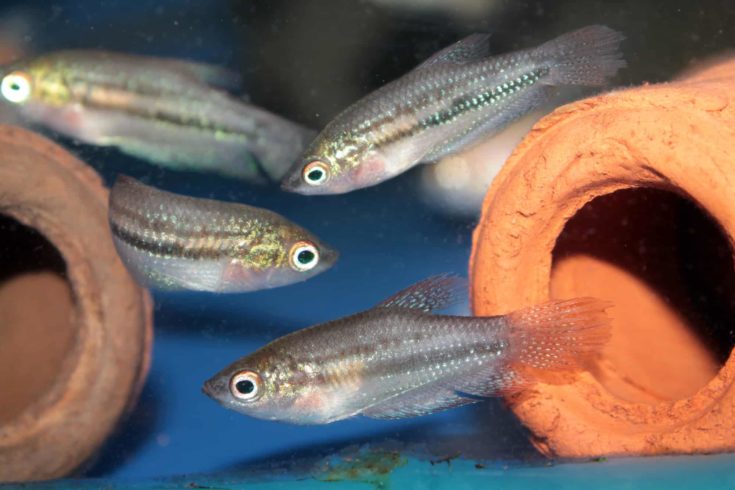
- They’re often found in shallow or stagnant ponds, streams and waterways and are commonly raised in artificial ponds and at commercial fish farms, especially in Southeast Asia.
- Most gouramis are omnivores and feed on insects, eggs and larvae floating in the water, but they also consume plant materials and some, like the Kissing Gourami, rasp algae off of rocks and leaves.
There’s more than 130 species of gourami identified in the wild and about 15 to 20 types that are commonly bred for sale in aquatic shops. Scientists are constantly rearranging their family trees and adjusting the nomenclature, so it can be tricky to make sense of the various names used for gouramis over the years.
- Gouramis are currently divided into three families. Originally, they were all grouped with the Giant and other Walking or Climbing Gourami in the Anabantidae family. Most aquarium species are now assigned to the Osphronemidae family, with the exception of the unique Kissing Gourami, which is in the Helostomatidae family.
- Several popular types have recently undergone a name change; for example, the Dwarf Gourami (also sold under the color varieties Powder Blue and Flame Red), was once identified as Colisa lalia, but is now called Trichogaster lalius.
- Several species (notably the Giant, Snakeskin and Paradise Gourami) are also important food animals and bred for local consumption as well as the international aquarium trade. You can actually order gourami meat online, too!
Gourami Gender, Size And Appearance
It’s hard to generalize about a gourami’s size or appearance, since it really depends on the specific type you’re interested in. Species of gourami can range from 1 inch in length to over 20, so it’s important that you choose the right pair for your tank and community!
Gouramis are popular due to the vivid colors and patterns they display, but it’s the male fish that are the showstoppers and really stand out in your tank:
- Male gouramis usually display bright iridescent colors and intricate patterns on their scales that can range from solid shades like the Blue or Gold Gourami, multi-colored fish like the blue/red Dwarf Gourami, speckled like a Sparkling Gourami, or rainbow-colored like the Paradise Fish.
- Some gouramis are noted more for their camouflage patterns rather than their colors, which is why the Banded, Snakeskin and Thick Lipped Gouramis have declined in popularity, but the slightly plain Three Spot Gourami is still one of the most popular morphs.
- Female gouramis of all types are rather plain compared to the males, and tend to be an iridescent silver or grey. It’s still best to add these fish in pairs or trios (2 females to 1 male) though, since male fish usually show off their best colors in the presence of their girlfriends!
Popular Types Of Gourami For Aquariums
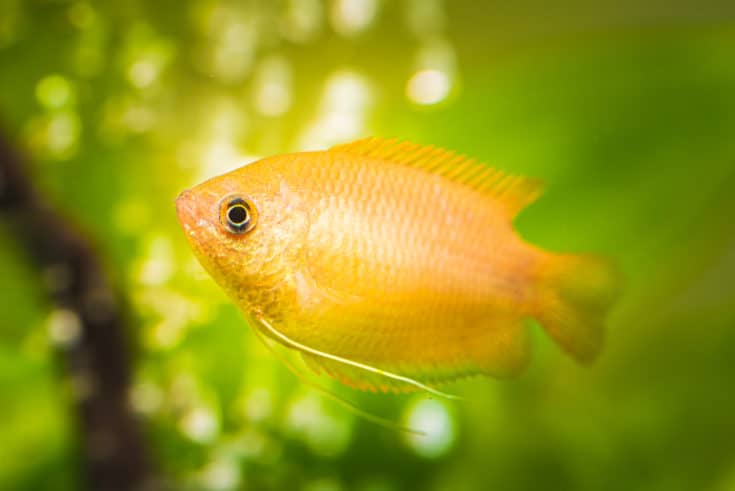
Which type of gourami should you get for your aquarium? The best pair really depends on the size of your tank, the type of community you have and how experienced you are with aquatics. You can check out the table below to see a list of the most popular types and species of gourami, along with their basic requirements.
Gouramis are often advertised by their color morphs instead of under their species name, which can lead to confusion if you’re not sure exactly what you’re buying. The Blue, Gold, Opaline and Three Spot Gourami, for instance, are actually all the same species of fish, Trichogaster trichopterus, even though they look quite different!
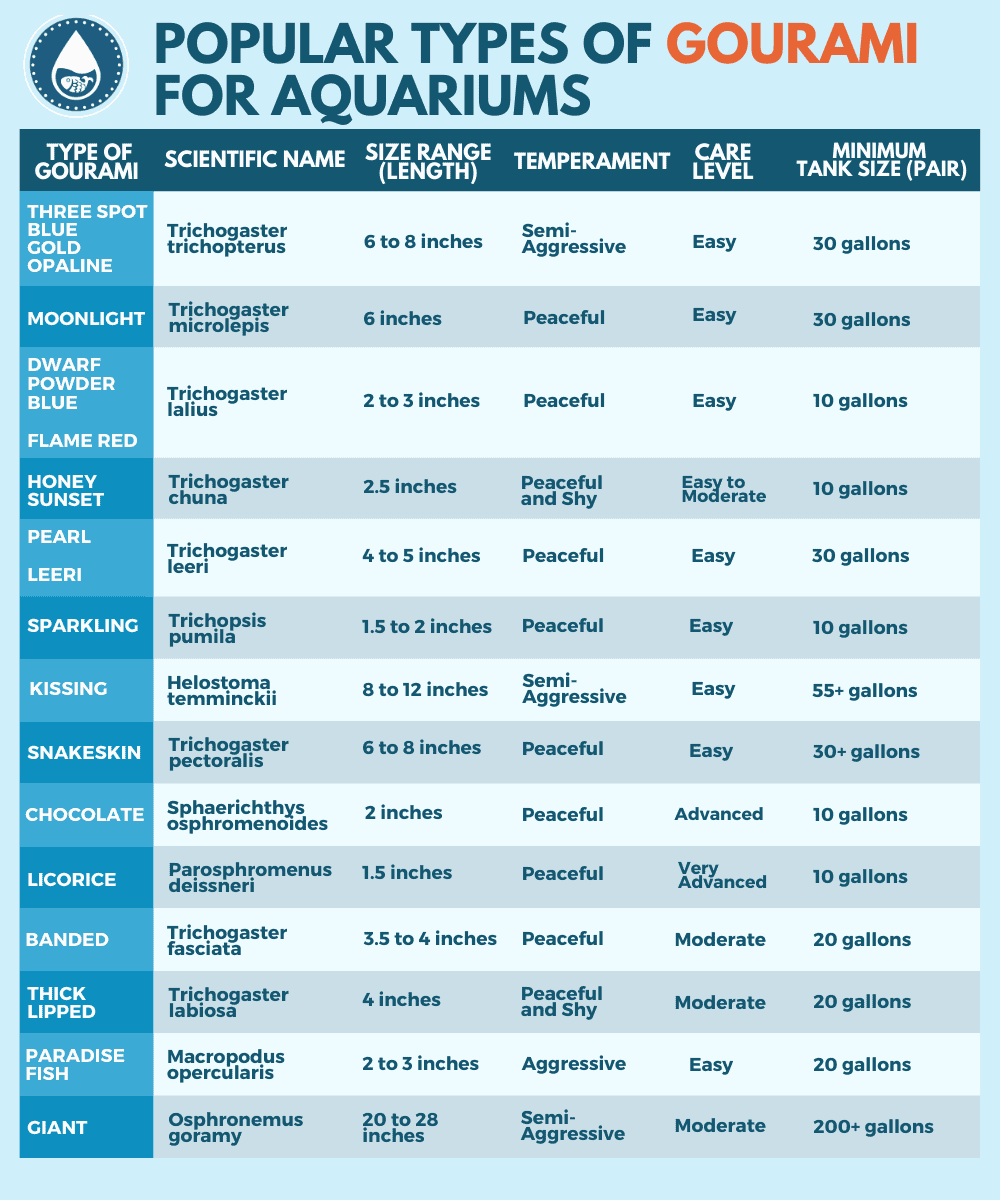
Gourami Lifespan
The lifespan of osphronemidae members like the betta and gourami is usually between 3 and 5 years, although with diligent care it’s not uncommon for them to live a lot longer. Kissing Gouramis often make it into their second decade, and Giant Gouramis can easily survive for 20 years or more in a spacious aquarium!
Behavior And Temperament Of Gouramis
Gouramis can be peaceful and even shy, semi-aggressive or aggressive, so it’s important to match their temperament to the rest of your aquatic community. Gouramis prefer to live in groups, so it’s best to add them in pairs or trios. Avoid keeping a solo gourami, since they’ll be stressed, depressed and unhappy.
Male gouramis can be territorial with each other, and even peaceful types may squabble over female fish if they don’t have the space to maintain separate territories. Unless you have a big aquarium, it’s better to keep one male gourami per tank, but you can usually keep one to three female fish for every male.
Choosing Tank Mates For Gourami Fish
How do you choose the best tank mates for a gourami set-up? It really depends on the type of gouramis you have. Aim to keep them with similar-sized fish with the same temperament, and be ready to make adjustments to your community as they mature and start to display their adult behaviors.
- The shy types, like the Honey, Sunset and Thick Lipped Gourami usually prefer quiet communities without a lot of action, so look for mellow tank mates like danios, rasboras, live-bearing mollies or platies and peaceful Cherry or Gold Barbs.
- Peaceful Moonlight, Dwarf, Pearl and Sparkling Gourami do very well in active but non-aggressive communities and are often kept with similar-sized tetras, rasboras, danios, loaches, small catfish and species of Corydoras.
- The popular and semi-aggressive Three Spot/Blue Gourami and Kissing Gourami varieties, on the other hand, do best when kept in pairs with other semi-aggressives like Tiger Barbs, plecostomus, Pictus Catfish and even some of the smaller cichlids.
- It can be very challenging to manage a tank with aggressive Paradise Gourami, so it may be better to keep them in a single-species set-up. You can try keeping them with large Bala Sharks, loaches and plecostomus, and some folks have been able to keep them with mature Common and Comet Goldfish, too.
How To Care For Your Gourami Tank
This is a brief overview of the ideal gourami set-up, but I recommend you research the specific preferences and requirements of the species you’re interested in, since there’s so much variation between the different types.
Tank Size, Set-up And Habitat Requirements
The ideal aquarium size for your pair of gouramis just depends on the species you’re keeping. Small varieties often do well in nano tanks from 10 to 30 gallons, while the larger species need from 55 to over 200 gallons. They’re usually not picky about their substrate, though, so you can use any type you prefer!
Gourami Filtration And Water Parameters
Gouramis prefer very clean and well-filtered water, but most don’t care for swimming in a current, so you may need to baffle your filtration system to reduce the flow rate across your tank. You can use any type of filter, but most are sensitive to toxins, so systems that use replaceable filter media are ideal.
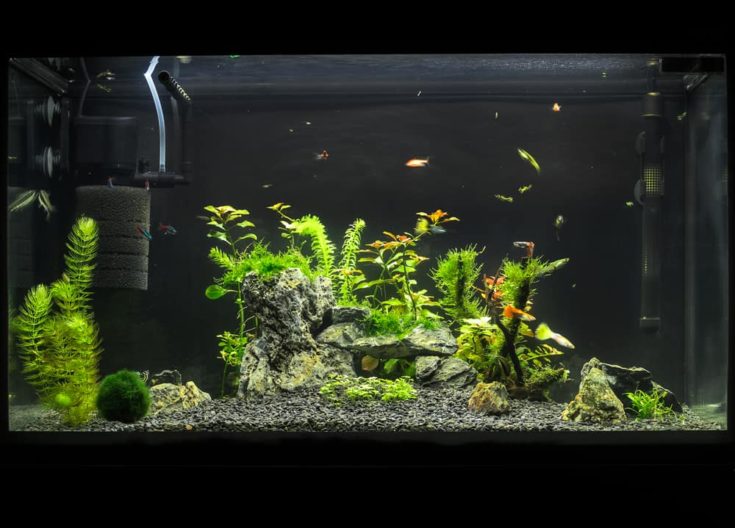
As you can see in the table below, the different species have unique needs when it comes to their water parameters. Dwarf Gouramis, for instance, prefer warm environments within a narrow range, while Paradise Fish can deal with water from 61 to 79°F!
One thing to note if you’d like to keep Chocolate or Licorice Gouramis is that they need very soft water in their tank to thrive. This parameter, along with their sensitivity to ammonia and nitrite/nitrates, are the reasons these species are only recommended for advanced or very advanced aquarists.
Type of Gourami
Three Spot
Temperature (°F)
75-86
pH
6.5 to 8.0
Hardness (dH)
5-18
Type of Gourami
Moonlight
Temperature (°F)
79-86
pH
6.0 to 7.0
Hardness (dH)
2-25
Type of Gourami
Dwarf
Temperature (°F)
77-82
pH
6.0 to 9.0
Hardness (dH)
5-20
Type of Gourami
Honey
Temperature (°F)
77-82
pH
6.0 to 7.5
Hardness (dH)
4-15
Type of Gourami
Pearl
Temperature (°F)
75-86
pH
6.5 to 8.0
Hardness (dH)
5-18
Type of Gourami
Sparkling
Temperature (°F)
72-80
pH
6.0 to 7.0
Hardness (dH)
4-10
Type of Gourami
Kissing
Temperature (°F)
72-82
pH
6.5 to 8.5
Hardness (dH)
5-20
Type of Gourami
Snakeskin
Temperature (°F)
72-86
pH
5.8 to 8.5
Hardness (dH)
2-30
Type of Gourami
Chocolate
Temperature (°F)
75-86
pH
6.0 to 7.6
Hardness (dH)
5-6
Type of Gourami
Licorice
Temperature (°F)
75-84
pH
6.0 to 7.2
Hardness (dH)
0-10
Type of Gourami
Banded
Temperature (°F)
70-82
pH
6.0 to 7.5
Hardness (dH)
5-15
Type of Gourami
Thick Lipped
Temperature (°F)
72-83
pH
6.0 to 7.0
Hardness (dH)
4-15
Type of Gourami
Paradise Fish
Temperature (°F)
61-79
pH
5.8 to 8.0
Hardness (dH)
5-30
Type of Gourami
Giant
Temperature (°F)
68-86
pH
6.5 to 8.0
Hardness (dH)
5-25
Type of Gourami
Three Spot
Moonlight
Dwarf
Honey
Pearl
Sparkling
Kissing
Snakeskin
Chocolate
Licorice
Banded
Thick Lipped
Paradise Fish
Giant
Temperature (°F)
75-86
79-86
77-82
72-82
75-86
72-80
72-82
72-86
75-86
75-84
70-82
72-83
61-79
68-86
pH
6.5 to 8.0
6.0 to 7.0
6.0 to 9.0
6.0 to 7.5
6.5 to 8.0
6.0 to 7.0
6.5 to 8.5
5.8 to 8.5
6.0 to 7.6
6.0 to 7.2
6.0 to 7.5
6.0 to 7.0
5.8 to 8.0
6.5 to 8.0
Hardness (dH)
5-18
2-25
5-20
4-15
5-18
4-10
5-20
2-30
5-6
0-10
5-15
4-15
5-30
5-25
Lights, Plants And Decorations
Wild gouramis live in densely planted shallow waters, but they don’t like bright lights, so it’s best to use plants and decor to reduce the glare in your tank. You can also float a few almond leaves or live plants on the surface to dim things down and naturally soften the water. They prefer tanks with lots of live plants, but most also enjoy swimming in open areas, so provide them with a mix for maximum fun!
Maintenance And Health Concerns
Most gouramis are easy to care for and fairly hearty, as long as you keep up on your filter maintenance and water changes. The sensitive Chocolate and Licorice Gouramis, on the other hand, have little tolerance for toxins and are easily stressed, so it’s important to keep their tanks pristine to avoid problems.
Gouramis are prone to developing various bacterial, fungal and viral infections like fin and tail rot, dropsy, popeye, hole-in-head and columnaris, and are also susceptible to the parasites that cause Ich or White Spot Disease. Dwarf Gouramis may also pick up an untreatable and eventually fatal viral infection called the Dwarf Gourami Iridovirus (DGIR).
Feeding Your Gouramis
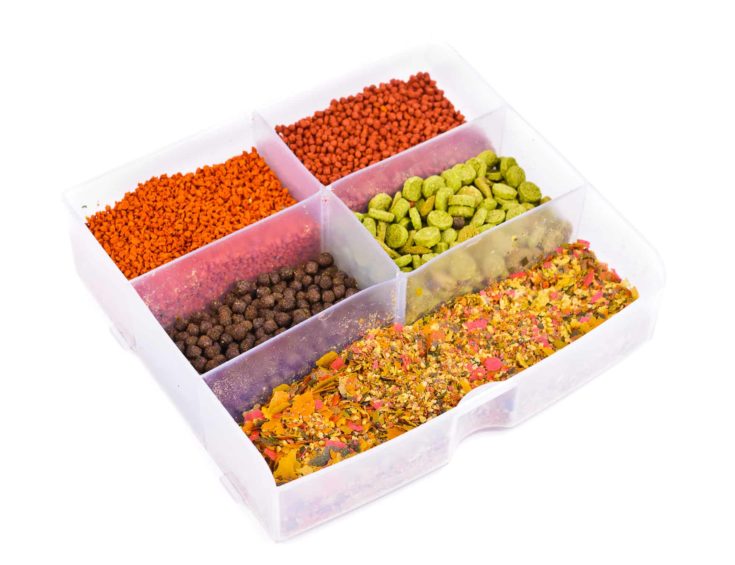
Gouramis are omnivores and usually do well when fed a commercial omnivore flake or pellet diet and supplemented with fresh, frozen or freeze-dried treats like brine shrimp, bloodworms, shrimp eggs, insects and larvae. You can also offer them algae wafers, spirulina flakes and freshly blanched veggies like spinach and zucchini.
Breeding Gouramis
Gouramis are egg layers and are usually one of the easier types of fish to breed in a home aquarium. While a few are mouthbrooders or egg scatters, most gouramis build bubble nests and have similar breeding requirements to the betta fish, so you can follow these instructions if you’d like to mate your pair!
Dwarf Gourami Aquarium: Equipment And Supply List
Here’s a list of the aquarium equipment and other supplies you’ll need to start a small tank for a pair of Dwarf Gouramis:
- 10-gallon aquarium with a lid and light fixture
- HOB, undergravel or internal filtration system
- Aquarium heater and temperature gauge
- Sand, soil or gravel substrate
- Variety of live plants and decor
To care for your Gourami Tank, you’ll need:
- Water conditioner
- Bucket, hose and gravel vacuum for water changes
- Filter media
- Commercial omnivore diets
- Treat foods
Some optional but useful supplies include:
- Almond leaves to soften the water
- Plant tools, fertilizers and/or CO2 injection systems
- Water testing kits (pH, hardness, ammonia, nitrite/nitrates)
- UV Sanitizer
Conclusion
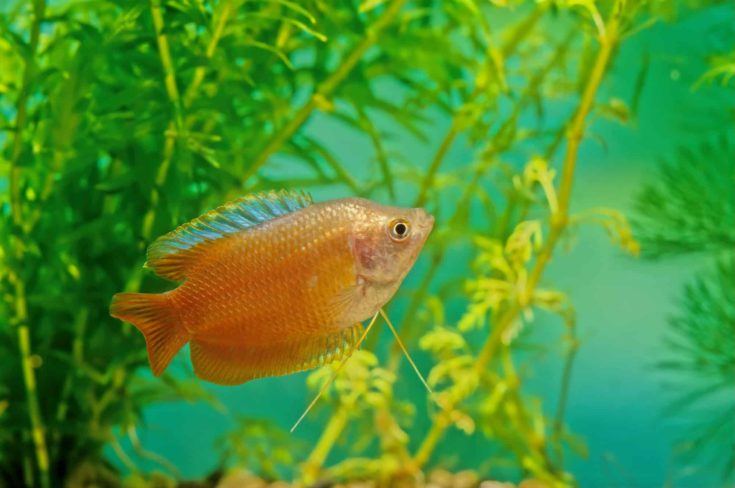
As you can see, there’s a species of gourami suitable for nearly any type of community and most are quite easy to care for! Have you had a pair of these magnificent fish, or are you planning to start a gourami tank? Share your thoughts or questions in the comments, or come join us on social media.
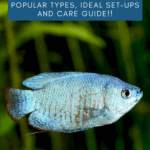
I have a silver gourami that has suddenly become quite big around the body but the head is still the normal size. Has it over eaten or is there some other reason . Tho other gouramis all seem ok iHave 2 silver and 2 opaline.thank you for any suggestions I cannot separate to another tank as dont have a spare